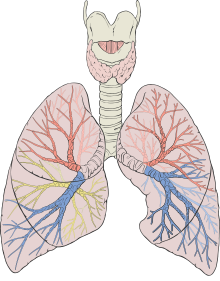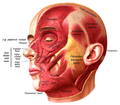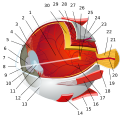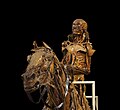Portal:Anatomy
Introduction
Anatomy (from Ancient Greek ἀνατομή (anatomḗ) 'dissection') is the branch of morphology concerned with the study of the internal structure of organisms and their parts. Anatomy is a branch of natural science that deals with the structural organization of living things. It is an old science, having its beginnings in prehistoric times. Anatomy is inherently tied to developmental biology, embryology, comparative anatomy, evolutionary biology, and phylogeny, as these are the processes by which anatomy is generated, both over immediate and long-term timescales. Anatomy and physiology, which study the structure and function of organisms and their parts respectively, make a natural pair of related disciplines, and are often studied together. Human anatomy is one of the essential basic sciences that are applied in medicine, and is often studied alongside physiology.
Anatomy is a complex and dynamic field that is constantly evolving as new discoveries are made. In recent years, there has been a significant increase in the use of advanced imaging techniques, such as MRI and CT scans, which allow for more detailed and accurate visualizations of the body's structures.
The discipline of anatomy is divided into macroscopic and microscopic parts. Macroscopic anatomy, or gross anatomy, is the examination of an animal's body parts using unaided eyesight. Gross anatomy also includes the branch of superficial anatomy. Microscopic anatomy involves the use of optical instruments in the study of the tissues of various structures, known as histology, and also in the study of cells. (Full article...)
Selected general anatomy article

Anatomical pathology (Commonwealth) or anatomic pathology (U.S.) is a medical specialty that is concerned with the diagnosis of disease based on the macroscopic, microscopic, biochemical, immunologic and molecular examination of organs and tissues. Over the 20th century, surgical pathology has evolved tremendously: from historical examination of whole bodies (autopsy) to a more modernized practice, centered on the diagnosis and prognosis of cancer to guide treatment decision-making in oncology. Its modern founder was the Italian scientist Giovanni Battista Morgagni from Forlì.
Anatomical pathology is one of two branches of pathology, the other being clinical pathology, the diagnosis of disease through the laboratory analysis of bodily fluids or tissues. Often, pathologists practice both anatomical and clinical pathology, a combination known as general pathology. Similar specialties exist in veterinary pathology. (Full article...)
Selected anatomical feature

The human nose is the first organ of the respiratory system. It is also the principal organ in the olfactory system. The shape of the nose is determined by the nasal bones and the nasal cartilages, including the nasal septum, which separates the nostrils and divides the nasal cavity into two.
The nose has an important function in breathing. The nasal mucosa lining the nasal cavity and the paranasal sinuses carries out the necessary conditioning of inhaled air by warming and moistening it. Nasal conchae, shell-like bones in the walls of the cavities, play a major part in this process. Filtering of the air by nasal hair in the nostrils prevents large particles from entering the lungs. Sneezing is a reflex to expel unwanted particles from the nose that irritate the mucosal lining. Sneezing can transmit infections, because aerosols are created in which the droplets can harbour pathogens.
Another major function of the nose is olfaction, the sense of smell. The area of olfactory epithelium, in the upper nasal cavity, contains specialised olfactory cells responsible for this function. (Full article...)
Selected organ
The lungs are the central organs of the respiratory system in humans and most other animals, including some snails and a small number of fish. In mammals and most other vertebrates, two lungs are located near the backbone on either side of the heart. Their function in the respiratory system is to extract oxygen from the air and transfer it into the bloodstream, and to release carbon dioxide from the bloodstream into the atmosphere, in a process of gas exchange. The pleurae, which are thin, smooth, and moist, serve to reduce friction between the lungs and chest wall during breathing, allowing for easy and effortless movements of the lungs.
Respiration is driven by different muscular systems in different species. Mammals, reptiles and birds use their different muscles to support and foster breathing. In earlier tetrapods, air was driven into the lungs by the pharyngeal muscles via buccal pumping, a mechanism still seen in amphibians. In humans, the main muscle of respiration that drives breathing is the diaphragm. The lungs also provide airflow that makes vocal sounds including human speech possible. (Full article...)
Selected biography

Henry Gray FRS (1827 – 13 June 1861) was a British anatomist and surgeon most notable for publishing the book Gray's Anatomy. He was elected a Fellow of the Royal Society (FRS) at the age of 25. (Full article...)
Selected images
Categories
WikiProjects
Some Wikipedians have formed a project to better organize information in articles related to Anatomy. This page and its subpages contain their suggestions; it is hoped that this project will help to focus the efforts of other Wikipedians. If you would like to help, please swing by the talk page.
WikiProject Anatomy update
| new good articles since last newsletter include Thyroid, Hypoglossal nerve, Axillary arch, Human brain, Cerebrospinal fluid, Accessory nerve, Gallbladder, and Interventricular foramina (neuroanatomy) | |
| There is Introduction to Anatomy on Wikipedia published in the Journal of Anatomy [1] | |
| We reach two projects goals of 20 good articles, and less than half of our articles as stubs, in July 2017. Wikipedia talk:WikiProject Anatomy/Archive 11#Congratulations to all | |
| A discussion about two preferred section titles takes place here. |
Things to do
- Participate in discussions - a number of discussions such as those on our talk page or about our infobox would benefit from your opinion!
- Continue to add content to our articles
- Collaborate and discuss with other editors - many hands make light work!
- Help us simplify our anatomy articles
- Improve and update existing articles (lists of articles needing improvement)
- Example missing articles: Wikipedia:Requested articles/list of missing anatomy
- Reduce the number of stubs
Topics
Related portals
Wikimedia
The following Wikimedia Foundation sister projects provide more on this subject:
-
Commons
Free media repository -
Wikibooks
Free textbooks and manuals -
Wikidata
Free knowledge base -
Wikinews
Free-content news -
Wikiquote
Collection of quotations -
Wikisource
Free-content library -
Wikiversity
Free learning tools -
Wiktionary
Dictionary and thesaurus
















